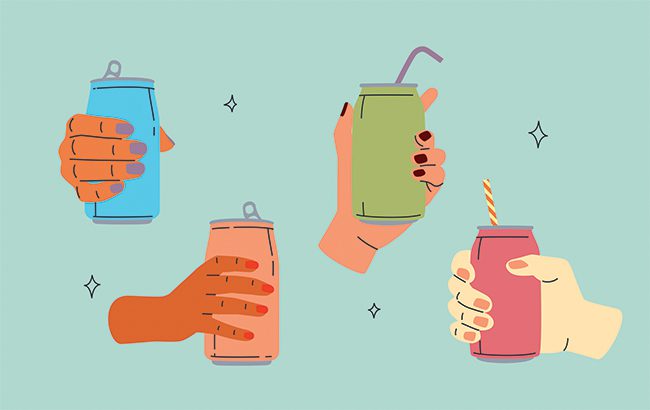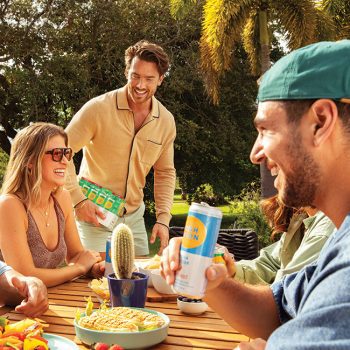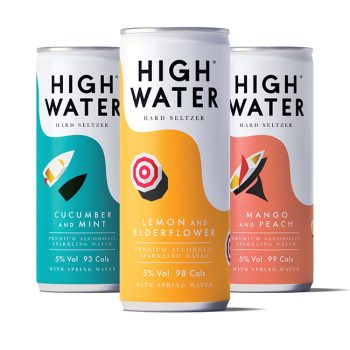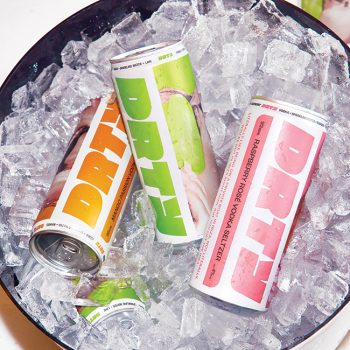Has hard seltzers’ fizz gone flat?
After the initial explosion in the popularity of hard seltzers, brands are facing a challenge to reinvigorate the market. Here’s how producers are planning to breathe fresh life into the category.

*This feature was originally published in the June 2024 issue of The Spirits Business magazine.
It’s hard to imagine a faster-moving category than hard seltzers. A few years ago, these colourful, convenient, low-cal cans emerged seemingly from nowhere, challenging all kinds of drinks categories and spawning a staggering number of brands. They’ve since hit their peak, and declined dramatically, and yet they keep evolving. The numbers may be down, but it seems there’s life in hard seltzer yet.
In terms of numbers, global hard seltzer volumes rose by a compound annual growth rate of 94% between 2017 and 2022 according to IWSR Drinks Market Analysis, contributing to 14% growth in overall ready-to-drinks (RTDs) over the same period, and resulting in a lot of excitement about the category. From 2021 to 2022, however, hard seltzer volumes fell by 9%, while overall RTDs grew by just 2%. In comparison, fellow RTD cocktails and long drinks grew by 10%, while wine spritzers and coolers rose by 6%. Those two categories, as well as hard seltzer, each account for a fifth of global RTD volumes, with catch-all flavoured alcoholic beverages responsible for half of the total volume.
On the whole, hard seltzer brands are certainly feeling it, not least in the US, which accounts for more than 90% of global hard seltzer volumes, according to the IWSR. Michael Spillane, president, CEO and director of The Boston Beer Company, which includes Truly Hard Seltzer in its portfolio, said in a recent earnings call: “We remain focused on stabilising Truly, and have seen sequential improvement in our lighter-flavour variety packs and single-serve packages. However, the hard seltzer category remains under pressure in 2024, and we continue to expect category volume declines in the low teens.”

Meanwhile, there are brands that are still finding success in the category, such as High Noon, part of the Spirit of Gallo portfolio. “High Noon has seen tremendous growth since launching in 2019,” says Britt West, Spirit of Gallo’s executive vice-president and general manager, who reports that the brand is both the top-selling spirits-based hard seltzer brand (in the 52 weeks to 3 March 2024), but also the number-one spirits brand by volume in the US.
Spirits-based hard seltzers – made with vodka and Tequila, primarily – have been the biggest success story in an otherwise declining category in recent years, taking up the mantle from the malt-based beverages that were the initial hard seltzer pioneers. “Spirit-based seltzers, as well as prepared cocktails, have been performing stronger than malt-based seltzers, albeit some of the softening demand is due to the prior significant, and unsustainable, growth trajectory,” says Adam Rogers, IWSR research director for North America. “The spirit base is evolving in the US, with malt-based brands launching vodka-based versions, as well as Tequila-based offerings.”
At Spirit of Gallo, West has seen this demand for spirit-based hard seltzers, saying that much of High Noon’s growth has been “driven by consumers looking for a premium alternative to beer and other malt-based hard seltzers or RTD offerings, which is where we’ve seen a real opportunity”.
Liquid quality
More broadly, West sees this as an advantage when competing with other RTD products, with the ability to communicate about the quality of the liquid, made with real juice and vodka or Tequila, with no added sugar. “In the past few years, RTDs have become significantly more popular, as consumers are looking for portable drink options, but there are also challenges – especially in a saturated market,” he says. “As more brands have entered the category, it has become increasingly difficult to get consumers’ attention, and there are also a few other misconceptions around RTDs, especially when it comes to ingredients and quality. Some of those challenges have helped High Noon stand out in the crowded market.”
A number of other brands are taking advantage of the appetite for spirit-based hard seltzers, including hard seltzer pioneer White Claw, which followed last year’s launch of its Vodka + Soda with a Tequila Smash range in March this year, initially launching in the US. In the UK, meanwhile, White Claw parent company Mark Anthony Brands recently introduced a new brand called Lemada, a lightly carbonated vodka and natural lemon drink.

Before UK brand High Water launched, the team had already identified the potential rise of spirit-based products in the category. “Having studied the US market before launch four years ago, we were well placed from the outset with our product offering, on-trend for key contributing factors driving growth in the category, including spirit-based products rather than malt or fermentation – High Water was vodka based from the start,” says founder Nick Britton.
Other factors that have been crucial to High Water’s success, in line with category trends, says Britton, are its sophisticated flavours, as well as a higher ABV relative to many other brands, 5% versus the more common 4%.
As the category evolves further into spirit-based products, while declining overall, some are exploring an adjacent category that’s on the rise – hard tea. “In the US, other RTD segments such as hard tea are trending, which is capturing a portion of consumer attention,” says Rogers. Global hard tea rose by 23% in volume between 2021 and 2022.
High Noon is among those getting in on the action, last month launching its own uncarbonated, tea-based offering, High Noon Vodka Iced Tea, in four flavours. “As we monitored RTD trends over the past year, hard tea continued to come up, and we saw another opportunity to disrupt a malt-based-dominated category,” says West.
Boston Beer Co, too, has been having success with its hard tea brand. “Truly is now a smaller part of our business mix with Twisted [Tea’s] strong growth,” said Spillane. The company is seeing success with its Twisted Tea Light range, at 4% ABV rather than the original’s 5%, and is testing a higher-ABV Extreme version too.
While the US remains the dominant market for hard seltzer, albeit in decline, the category has made its presence felt in other global markets in the past few years. “We see a mixed performance elsewhere, but in other key markets such as Canada and Australia, the pattern is similar to the US, with a peak in 2021/2022, and now in decline,” says Rogers.
In the UK, White Claw continues to gain ground. Michael Dean, the brand’s marketing director, cites Circana data that shows volume growth for the brand of 43%, MAT to 14 April 2024. “Despite the challenges of the hard seltzer category, White Claw is performing extremely well in a declining market,” he says, adding that innovation in RTD cocktails in the UK has allowed the hard seltzer brand to offer a point of difference.
Britton, too, sees the benefits in the broader category’s evolution in the UK in recent years. “The overall rise of RTDs is nothing but positive news for us, as it means greater attention and space is being given to packaged products that consumers are desiring,” he says. “Hard seltzers are filling the unique space of offering a lower calorie, lower sugar choice, without the need to compromise on taste.”
In some ways, the UK’s hard seltzer category is still developing, believes Britton. “The main challenge is still around awareness and trial, but we are seeing increases in both,” he says. “One issue that faced the category was a glut of sub-standard products launching into the market that disappointed in terms of consumer experience. However, the market is now consolidating, with White Claw establishing itself as the leading mainstream brand, and High Water leading the premium end of the category.”

There are challenges specific to markets like the UK, says Matija Pisk, director of hard seltzer brand DRTY. “Seasonality will always be a challenge here,” he says. “There are plenty of bullseye drinking occasions for hard seltzer, but these are largely seen in the warmer months of the year.”
Critical channel
For Pisk, there are certain channels that are better suited to hard seltzers than others. “The convenience channel is critical, because this is where the chillers are. Being cold and in the chiller is critical for the on-the-go, impulse occasion,” he says, although he acknowledges that the on-trade presents an opportunity too, particularly in venues suited to canned drinks, such as music-led sites.
For some brands, the on-trade presents an even broader opportunity. “In the UK, premium on-trade across multiple sub segments have demonstrated good demand for High Water, and we are now selectively expanding in the off-trade, in places that fit our brand credentials,” says Britton.
The same is true in more established markets, where the on-trade might offer hope for brands experiencing challenges in other channels. “In the US, hard seltzers continue to make inroads in the on-premise channel for brands with loyal consumer bases,” confirms the IWSR’s Rogers, who adds: “Overall, the segment is rationalising, with clear leaders being established, and ‘me too’ brands falling out of fashion.”
That rationalisation, along with other developments – whether that’s new spirit-based products or new channels – will no doubt be quick. This is hard seltzer, after all.
Related news
Gossip Girl ‘spills the tea’ on Betty Booze RTDs
